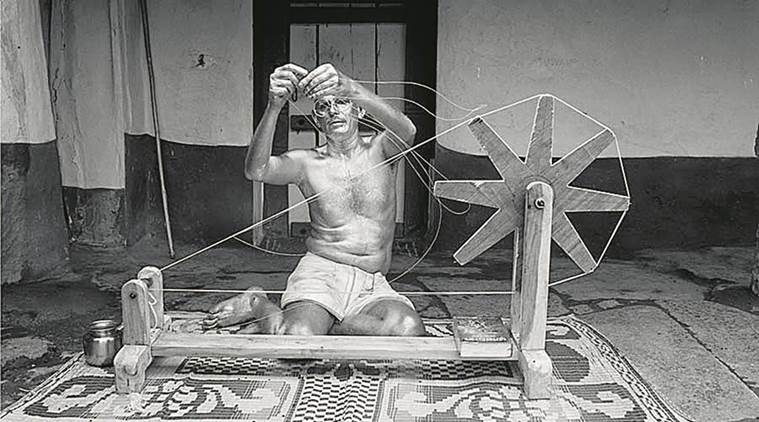
A resident of Bagadehalli village in Kadur, Karnataka, Bagadehalli Basavaraj discovered a rather unique way of reminding people about Gandhi and his ideas. The school teacher would dress up as Gandhi and walk the streets. Some years ago, he caught the eye of Bengaluru-based photographer Cop Shiva, who decided to document his life, leading to one of his own acclaimed series, “Being Gandhi”. The protagonist is 40-something Basavaraj, doused in silver paint and dressed as Gandhi — bare-chested, dhoti-clad, spectacled, with a walking stick.
The series sets the tone for the exhibition “Mahatma: Self or Nation?” at Art Heritage in Delhi. “Now more than ever before, we need to rediscover Gandhi — these are times when freedom of all kinds are limited or snatched away. Heinous crimes are committed in the name of nationalism. Gandhi’s kind, gentle visage soothes us, as it stands in opposition to the angry, distorted faces of today’s politicians.
Unlike today, where we are forced to accept irrationality as a norm, Gandhi inspires us to think freely and rationally, because he categorically believed that people should have the freedom of choice. As the politics of the day, both nationally and internationally, call to divide people, suppress voices that seek equality and freedom for the oppressed, the works in the exhibition bring to the fore the artist’s depictions of protest, leadership and resistance — and ask the viewer to ponder these themes as they navigate the exhibition space,” says curator Amal Allana.

At the entrance of the gallery is a set of 100 postcards designed by some of India’s most prominent artists — including Nalini Malani, Atul Dodiya and Arpana Caur — put together by Sahmat to celebrate 150 years of Mahatma Gandhi’s birth in 2018. On the opposite wall is the late artist Yusuf Arakkal’s mixed media work with Gandhi urging for peace in the center of its frame. If a screen is playing episodes of the Gandhi-Broomfield trial from the critically acclaimed television mini-series, Raj Se Swaraj, directed by Allana, Vidya Sagar Singh’s light sculptures Tree of Life instill hope. “Given the curatorial impetus for this exhibition, artists’ works thematically examine equality, justice and protest,” says Allana.
In Visakhapatnam-based artist, Jagadeesh Tammineni’s woodcuts titled Birth of a Nation we see Gandhi working on nation-building. Making metaphorical references, the series has a mechanised peacock, cow, and tiger, with Gandhi seated alongside, tackling the complexities of the nation, where there is an emphasis on the traditional and the modern as well as technological advancement. “I believe his ideas of non-violence, as well as nation building, are still valid in the 21st century, racked as we are by sectarian violence.

The act of building in a democratic liberal nation has its own pitfalls and the path is strewn with difficulties. Gandhiji still holds the key,” says Tammineni, a graduate from MS University. We also see the citizens of India, with their aspirations and fight for justice. Ronney Sen’s greyscale photographs capture Gandhi’s spirit of Satyagraha, adopted by thousands of protesters on the streets of Kolkata in 2014, who had assembled to show solidarity with students of Jadavpur University attacked by the police when they were demanding justice after a girl was molested on campus.
The common man comes to the forefront, as he also does in Suresh Punjabi’s set of photographs from the ’70s and ’80s, shot in Studio Suhag, a photo studio in Nagda, a small town in Madhya Pradesh. “Looked at closely, these seemingly innocuous photos, reveal the need for an assertion of identity by those photographed. Using props and costumes, men, women and entire families seem eager to appear upwardly mobile, making a statement through their poses and gestures that mimic popular film stars,” reads a gallery note.
The exhibition is at Art Heritage, Triveni Kala Sangam, from July 1 to 31